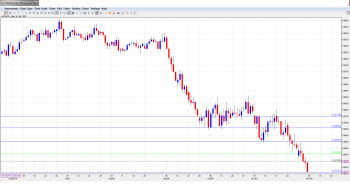The Australian dollar lost over 100 points last week, as AUD/USD dropped to its lowest level since July 2010. The pair closed the week just above the 0.83 line. This week’s key indicators are NAB Business Confidence and Employment Change. Here is an outlook on the major market-movers and an updated technical analysis for AUD/USD.
In Australia, GDP missed expectations and Retail Sales softened last month. Over in the US, Non-Farm Payrolls report was outstanding with a 321K job gain in November and finally a bump in wages.
[do action=”autoupdate” tag=”AUDUSDUpdate”/]AUD/USD graph with support and resistance lines on it. Click to enlarge:
- ANZ Job Advertisements: Monday, 00:30. This indicator is an important gauge of the employment market. The indicator dropped to 0.2% in October, marking a five-month low. The markets will be hoping for a stronger gain in the upcoming release.
- Chinese Trade Balance: Monday, Tentative. The Australian dollar is sensitive to key Chinese numbers, as the Asian giant is Australia’s number one trade partner. Chinese trade surplus was up strongly in October, climbing to $45.4 billion. Another strong reading is expected in November, with a forecast of $44.3 billion.
- NAB Business Confidence: Tuesday, 00:30. This is the first key event of the week. Business Confidence continues to lose ground, falling to 4 points in October. If the downward trend continues, the Aussie could lose ground.
- Westpac Consumer Sentiment: Tuesday, 23:30. Consumer Sentiment has been moving higher and posted a gain of 1.9% last month. Will the upward trend continue this month?
- Home Loans: Wednesday, 00:30. Home Loans is an important gauge of the strength of the housing sector. After a string of gains, the indicator has posted two straight declines, with a reading of -0.7% in September. The markets are expecting a strong turnaround in the upcoming release, with an estimate of 0.2%.
- Chinese CPI: Wednesday, 1:30. Chinese CPI has been softening, reflecting a slowing Chinese economy, which is bad news for Australian exports. The index remained steady at 1.6% in the last reading, matching the forecast. No change is expected in November reading.
- MI Inflation Expectations: Thursday, 00:00. Inflation Expectations is carefully monitored by the markets, as consumer expectations can translate into actual inflation. The October reading posted a sharp gain of 4.1%, its strongest gain in six months.
- Employment Change: Thursday, 00:30. Employment Change is one of the most important indicators and should be treated as a market-mover. The indicator bounced back in October with a strong gain of 24.1 thousand, beating an estimate of 20.3 thousand. The markets are expecting a smaller gain of 15.2 thousand in November.
- Chinese Industrial Production: Friday, 5:30. Chinese industrial production has softened since mid-2014, when the production was around 9%. In October, the indicator came in at 7.7%, short of the forecast of 8.0%. Little change is expected in the upcoming release, with an estimate of 7.6%.
* All times are GMT.
AUD/USD Technical Analysis
AUD/USD started the week at 0.8440 and quickly climbed to a high of 0.8543, as resistance held at 0.8550 (discussed last week). It was all downhill after that, as the pair dropped all the way to 0.8312, which is where the pair closed the week.
Live chart of AUD/USD: [do action=”tradingviews” pair=”AUDUSD” interval=”60″/]
Technical lines from top to bottom:
With the Australian dollar sustaining losses, we begin at lower levels:
0.89o8 has held firm since mid-November. The next line of resistance is at 0.8750.
0.8660 is a strong resistance line.
0.8550 held firm as the Aussie showed some strength early in the week before heading lower.
0.8456 was tested but remains a strong resistance line.
0.8316 is fluid, as the pair closed the week just below this line. Look for this line to see action early in the week.
0.8150 has remained intact since September 2007.
0.8013 is the last barrier in front of the psychologically critical line of 0.8000.
0.7978 was an important cap in January 2007. It is the final line for now.
I remain bearish on AUD/USD.
US employment numbers were back on track last week, thanks to an excellent jobs report and some wage inflation as well. This should help ease concerns about whether the Fed remains on track for a rate hike in the first half of 2014. Australian numbers remains weak, which is weighing on the wobbly Australian dollar.
In our latest podcast, we preview December’s big events, talk about the importance of jobless claims, the crash in oil prices and GOFO going negative:

